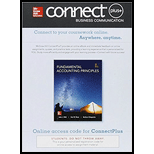
Introduction:
Contribution Margin Ratio is calculated by dividing Contribution Margin by Total Sales. It is the difference between Selling Price and Total Variable Costs expressed as a percentage. It depicts the percentage of Revenue available to cover Fixed Cost and generate profits.
Break- even point is calculated by dividing Total Fixed Costs incurred by Contribution Margin per unit of the product. It is a point where Total Revenue equals the Total Costs of the concern. In simple terms, it is the point where there is no profit or loss. After this point, Revenue begins to exceed the Costs incurred.
To determine:
(1) Contribution Margin Ratio and (2) Break- even point in dollars of SBD Phone Company
Want to see the full answer?
Check out a sample textbook solution
Chapter 21 Solutions
Connect 2-Semester Access Card for Fundamental Accounting Principles
- Solve this Accounting questionarrow_forwardYour manager asks you to compute the company's cash conversion cycle. Looking at the financial statements, you see that the average inventory for the year was $215,500, accounts receivable were $172,600, and accounts payable were at $198,300. You also see that the company had sales of $547,000 and that cost of goods sold was $382,000. What is your firm's cash conversion cycle? Round to the nearest day.arrow_forwardNeed help general accounting questionarrow_forward
- Your supervisor at Clearview Corp. asks you to compute the company's cash conversion cycle. Looking at the financial statements, you see that the average inventory for the year was$142,800, accounts receivable were $96,500, and accounts payable were $111,600. You also see that the company had sales of $312,000 and that cost of goods sold was $275,000. What is the firm’s cash conversion cycle? (Round to the nearest day.) answerarrow_forwardThe total assets of a company amount to $845,000, while the total liabilities are $315,000.arrow_forwardSuppose that Dawson Manufacturing has annual sales of $5.83 million, cost of goods sold of $2,450,000, average inventories of $1,225,000, and average accounts receivable of $890,000. Assume that all of Dawson's sales are on credit. What will be the firm's operating cycle? (Use 365 days a year. Do not round intermediate calculations. Round your final answer to 2 decimal places.)arrow_forward

 AccountingAccountingISBN:9781337272094Author:WARREN, Carl S., Reeve, James M., Duchac, Jonathan E.Publisher:Cengage Learning,
AccountingAccountingISBN:9781337272094Author:WARREN, Carl S., Reeve, James M., Duchac, Jonathan E.Publisher:Cengage Learning, Accounting Information SystemsAccountingISBN:9781337619202Author:Hall, James A.Publisher:Cengage Learning,
Accounting Information SystemsAccountingISBN:9781337619202Author:Hall, James A.Publisher:Cengage Learning, Horngren's Cost Accounting: A Managerial Emphasis...AccountingISBN:9780134475585Author:Srikant M. Datar, Madhav V. RajanPublisher:PEARSON
Horngren's Cost Accounting: A Managerial Emphasis...AccountingISBN:9780134475585Author:Srikant M. Datar, Madhav V. RajanPublisher:PEARSON Intermediate AccountingAccountingISBN:9781259722660Author:J. David Spiceland, Mark W. Nelson, Wayne M ThomasPublisher:McGraw-Hill Education
Intermediate AccountingAccountingISBN:9781259722660Author:J. David Spiceland, Mark W. Nelson, Wayne M ThomasPublisher:McGraw-Hill Education Financial and Managerial AccountingAccountingISBN:9781259726705Author:John J Wild, Ken W. Shaw, Barbara Chiappetta Fundamental Accounting PrinciplesPublisher:McGraw-Hill Education
Financial and Managerial AccountingAccountingISBN:9781259726705Author:John J Wild, Ken W. Shaw, Barbara Chiappetta Fundamental Accounting PrinciplesPublisher:McGraw-Hill Education





